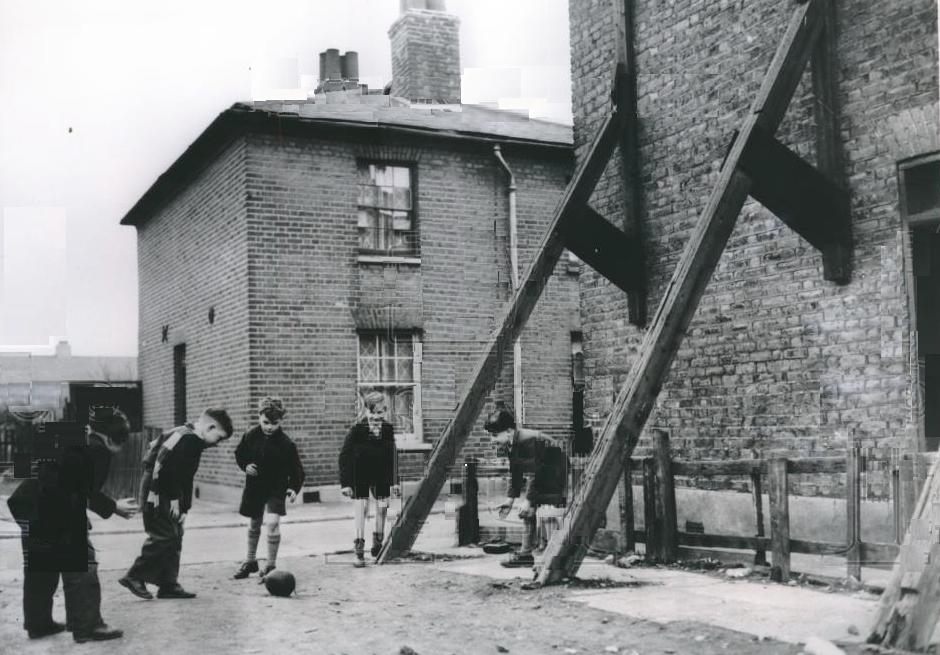
World War II: British Aftermath and Recovery--Housing

Figure 1.-- Housing was another serious problem Britain faced after the War. Actually it did not begin with the War. Many workers beefore the War lived in substandard housing without running water. The housing pattern in Britain was diiferent than in Germany. Relatively few British workers lived in large multi-level apartment flats like German workers. Rather they tended to live in subsandard single-family hosing. Actually this created a problem for the Luftwaffe. British cities were so spread out that it took enormous resources to attack them, resources the Germans did not have and could never replace. They could destroy British homes, but not a critical mass and only by sacrificing irreplacable military resources with no aprecable impact on the British war effort. The Blitz was only one of the many military mistakes made by Hitler. The Luftwaffe had not seriously damaged British war industries during the War, they had destroyed large numbers of homes in London and other major cities. During the War, labor and materil shortages made it impossible to address the problem. The new Labour Government's answer to the problem not just to build new housing, but to tear down slum housing and move people to newly counstructed urban council flats or out of the cities entirely. To accomplish its goals, Labour passed the New Towns Act (1946). The result was expanding towns around London. A good example was Harlow. They were to take London's overspill population. They also began to create new industrial centres. Peterlee in the north (county Durham) is a good example. The new towns effort was just beginning by 1950 and it was not going well. The local authorities lacked the needed resources to deal with the housing shortage. Nearly half the population living in these new cities had to be accomodated in private rental housing. One source described these accomodations as commonly 'dingy rooms or bedsits with little privacy, comfort or warmth'. Less than a third of the houses in these new citiues were owner occupied. The vast majority of buildings were unmodernized designs and construction, built of brick or stone. There were almost no high rise buildings. Concrete tended to be used mostly for military structures. This only began changing rapidly in the late 1950s and 1960s
|
|
Housing was another serious problem Britain faced after the War. Actually it did not begin with the War. Many workers beefore the War lived in substandard housing without running water. The housing pattern in Britain was diiferent than in Germany. Relatively few British workers lived in large multi-level apartment flats like German workers. Rather they tended to live in subsandard single-family hosing. Actually this created a problem for the Luftwaffe. British cities were so spread out that it took enormous resoirces to attack ghem, resources the Germans did not have. They could destroy British homes, but not a criutical mass and only by sacrificing irreplacable military resources with no aprecable impact on the British war effort. The Blitz was only one of the many military mistakes made by Hitler. The Luftwaffe had not seriously damaged British war industries during the War, they had destroyed large numbers of homes in London and other major cities. During the War, labor and materil shortages made it impossible to address the problem. The new Labour Government's answer to the problem not just to build new housing, but to tear down slum housing and move people to newly counstructed urban council flats or out of the cities entirely. To accomplish its goals, Labour passed the New Towns Act (1946). The result was expanding towns around London. A good example was Harlow. They were to take London's overspill population. They also began to create new industrial centres. Peterlee in the north (county Durham) is a good example. The new towns effort was just beginning by 1950 and it was not going well. The local authorities lacked the needed resources to deal with the housing shortage. Nearly half the population living in these new cities had to be accomodated in private rental housing. One source described these accomodations as commonly 'dingy rooms or bedsits with little privacy, comfort or warmth'. Less than a third of the houses in these new citiues were owner occupied. The vast majority of buildings were unmodernized designs and construction, built of brick or stone. There were almost no high rise buildings. Concrete tended to be used mostly for military structures. This only began changing rapidly in the late 1950s and 1960s.
CIH

Navigate the CIH World ar II Pages:
[Return to World War II: Main British aftermath and recovery page]
[Return to World War II: Main England page]
[Return to World War II: Main recovery page]
[About Us]
[Biographies]
[Campaigns]
[Children]
[Countries]
[Deciding factors]
[Diplomacy]
[Geo-political crisis]
[Economics]
[Home front]
[Intelligence]
[POWs]
[Resistance]
[Race]
[Refugees]
[Technology]
[Totalitarian powers]
[Bibliographies]
[Contributions]
[FAQs]
[Images]
[Links]
[Registration]
[Tools]
[Return to Main World War II page]
[Return to Main war essay page]
[Return to CIH Home page]
Created: 9:52 PM 8/20/2018
Last updated: 9:52 PM 8/20/2018



